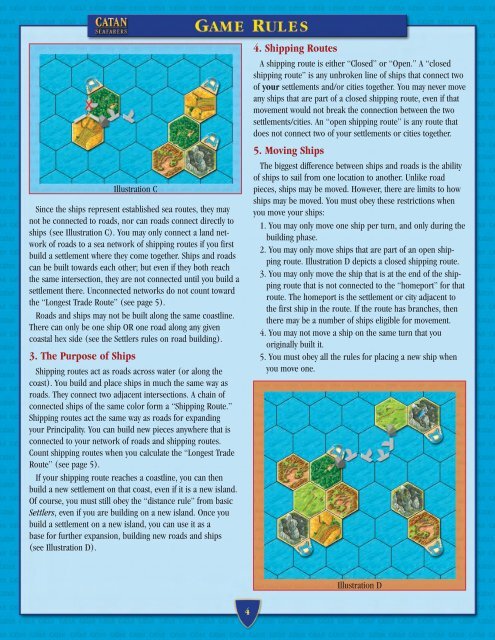Seafarers Rules - Mayfair Games
Seafarers Rules - Mayfair Games
Seafarers Rules - Mayfair Games
You also want an ePaper? Increase the reach of your titles
YUMPU automatically turns print PDFs into web optimized ePapers that Google loves.
Illustration C<br />
Since the ships represent established sea routes, they may<br />
not be connected to roads, nor can roads connect directly to<br />
ships (see Illustration C). You may only connect a land network<br />
of roads to a sea network of shipping routes if you first<br />
build a settlement where they come together. Ships and roads<br />
can be built towards each other; but even if they both reach<br />
the same intersection, they are not connected until you build a<br />
settlement there. Unconnected networks do not count toward<br />
the “Longest Trade Route” (see page 5).<br />
Roads and ships may not be built along the same coastline.<br />
There can only be one ship OR one road along any given<br />
coastal hex side (see the Settlers rules on road building).<br />
3. The Purpose of Ships<br />
Shipping routes act as roads across water (or along the<br />
coast). You build and place ships in much the same way as<br />
roads. They connect two adjacent intersections. A chain of<br />
connected ships of the same color form a “Shipping Route.”<br />
Shipping routes act the same way as roads for expanding<br />
your Principality. You can build new pieces anywhere that is<br />
connected to your network of roads and shipping routes.<br />
Count shipping routes when you calculate the “Longest Trade<br />
Route” (see page 5).<br />
If your shipping route reaches a coastline, you can then<br />
build a new settlement on that coast, even if it is a new island.<br />
Of course, you must still obey the “distance rule” from basic<br />
Settlers, even if you are building on a new island. Once you<br />
build a settlement on a new island, you can use it as a<br />
base for further expansion, building new roads and ships<br />
(see Illustration D).<br />
4. Shipping Routes<br />
A shipping route is either “Closed” or “Open.” A “closed<br />
shipping route” is any unbroken line of ships that connect two<br />
of your settlements and/or cities together. You may never move<br />
any ships that are part of a closed shipping route, even if that<br />
movement would not break the connection between the two<br />
settlements/cities. An “open shipping route” is any route that<br />
does not connect two of your settlements or cities together.<br />
5. Moving Ships<br />
The biggest difference between ships and roads is the ability<br />
of ships to sail from one location to another. Unlike road<br />
pieces, ships may be moved. However, there are limits to how<br />
ships may be moved. You must obey these restrictions when<br />
you move your ships:<br />
1. You may only move one ship per turn, and only during the<br />
building phase.<br />
2. You may only move ships that are part of an open shipping<br />
route. Illustration D depicts a closed shipping route.<br />
3. You may only move the ship that is at the end of the shipping<br />
route that is not connected to the “homeport” for that<br />
route. The homeport is the settlement or city adjacent to<br />
the first ship in the route. If the route has branches, then<br />
there may be a number of ships eligible for movement.<br />
4. You may not move a ship on the same turn that you<br />
originally built it.<br />
5. You must obey all the rules for placing a new ship when<br />
you move one.<br />
Illustration D<br />
4



